#digital farming tools
Explore tagged Tumblr posts
Text
Safaricom & NGO Launch FarmerAI Solutions to Revolutionize Kenyan Agriculture
Safaricom PLC and Opportunity International, a global non-governmental organization, have developed FarmerAI in Kenya, an innovative AI chatbot that will provide smallholder farmers in underserved communities with real-time, relevant farming best practices. As per a 2022 report from the Kenya National Bureau of Statistics (KNBS), the agricultural sector contributes roughly 22.4% to the country’s…
#agricultural development#Agricultural Innovation#agricultural productivity#AI chatbot#AI farming solutions#AI for farmers#AI in agriculture#Crop management#digifarm#digital divide#digital farming tools#FarmerAI#farming best practices.#Farming technology#Food security#Kenya agriculture technology#Kenyan agriculture#kenyan farmers#market prices#NGO#Opportunity International#pest control#rural farmers#safaricom#smallholder farmers#sustainable farming#weather forecasting
0 notes
Text

#kirby#bugs#worm#ask to tag#daily kirby#my art#digital#hal laboratory#nintendo#I would always hang out with my dad when he gardened and take every worm he dug up#to carry it gently around the yard and eventually set it safely away from the garden tools#they're so cute I love them#the worst part about my wheelchair is it's much harder to stop and move worms out of harm's way :(#I wanna make a little worm farm once we have more space#like obviously there's value in it and it can either benefit your own garden or make a little profit in the right neighborhood#but it's entirely an excuse to own Many Worms.#favorites
191 notes
·
View notes
Text
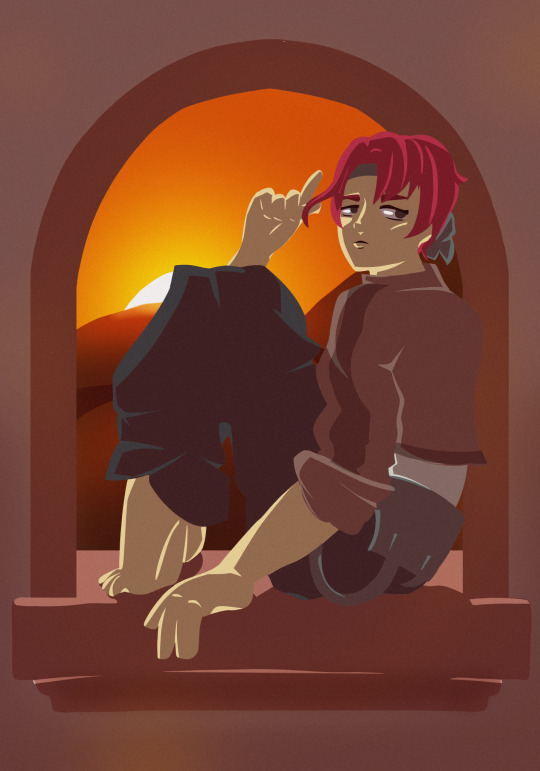
march seated on a window sill :-)
#fields of mistria#farm sim#fom march#kleki paint tool#art#digital art#ive been working on this for hours#and i still cant get it to look right#so im leaving it as is lol#i hate this man#i love this man
14 notes
·
View notes
Text
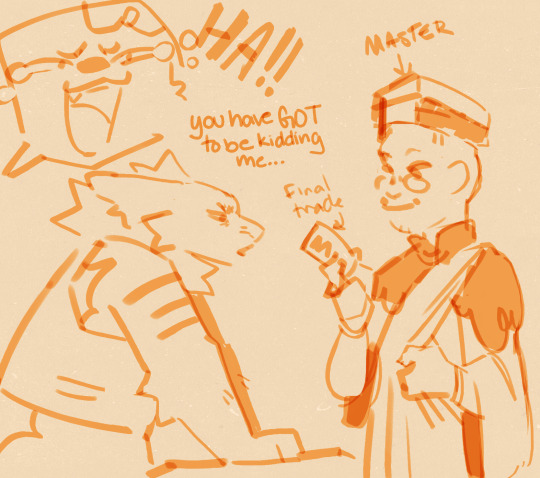
My luck in minecraft has not gotten much better these last months but still we stay silly and prevail djsmfldskjfsdfklj
#i'm trying so hard to get mending so that i can stop having to make new armor nd tools while farming for this build#but this villager was literally like. nah. nametags be upon ye#whatever. go my scarab.#squisheebug doodles#digital doodles#digital art#furry art#sfw furry#furry artist#minecraft monday#sorry all the last minecraft mondays have been me being grumpy i love this game but man it is kicking me in the ass when it comes to luck#dean tag
9 notes
·
View notes
Text
#BYDFi#crypto trading#decentralized finance#DeFi#cryptocurrency#blockchain#digital assets#trading platform#crypto exchange#BYDFi features#crypto investment#yield farming#staking#DeFi protocols#crypto trading tools.
0 notes
Text
Forgotten Bible Heroes - Shamgar

(Pencil and digital original work)
No one knows who he was; no one knows his real name. All that is known is his one heroic feat: killing 600 Philistine warriors with an oxgoad. What tragedy had driven him from his home? Did he die in this effort? Did he meet the God of Israel? Will we ever know?
Video explanation here: https://youtu.be/FCVfcfom_Ao?si=HFVqOZUU2PVOl3gU
youtube
#shamgar#killed 600 philistines with an oxgoad#epic heroes of history#on par with Odysseus#bible story#god#deliverance#old testament#unknown#unsung heroes#artwork#drawing#pencil sketch#digital art#art tumblr#Youtube#judges#judgement#vengeance#the punisher#judaism#christianity#history#Sunday#awesamdude#farm tools#six sentence sunday
0 notes
Text
Discovering the Power of Reaper: My Go-To DAW for Music Production
In the expansive world of digital audio workstations (DAWs), Reaper stands out not just for its robust features and affordability but as my DAW of choice for all my music production needs. From the intricate beats crafted for the Garlic Farm project to the diverse soundscapes explored in my other works, Reaper has been an indispensable tool in my creative arsenal. Here’s why Reaper has earned its…
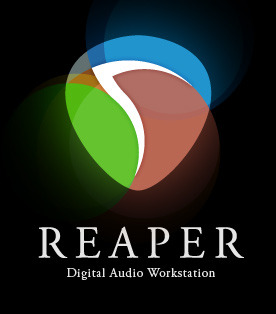
View On WordPress
#Advanced Music Production#Audio Editing#Audio Mixing#Audio Production Tips#Audio Routing#Beat Making#Beatstars#Customizable DAW#Digital Audio Workstation#Efficient Music Software#Free Beats Download#Garlic Farm Project#Home Studio Setup#MIDI Sequencing#Multi-Platform DAW#Music Automation#Music Composition#Music Creation Tools#Music Production#Music Production Guide#Music Software Review#Professional Audio#Reaper DAW#Reaper for Beginners#Recording Software#Sound Design#VST Plugins
1 note
·
View note
Text
Excerpt from this story from Common Dreams:
Climate defenders and farmers sued the Trump administration in federal court on Monday over "the U.S. Department of Agriculture's unlawful purge of climate-related policies, guides, datasets, and resources from its websites."
The complaint was filed in the Southern District of New York by Earthjustice and the Knight First Amendment Institute at Columbia University on behalf of the Environmental Working Group (EWG), Natural Resources Defense Council (NRDC), and Northeast Organic Farming Association of New York (NOFA-NY).
The case focuses on just one part of Republican President Donald Trump's sweeping effort to purge the federal government and its resources of anyone or anything that doesn't align with his far-right agenda, including information about the fossil fuel-driven climate emergency.
"USDA's irrational climate change purge doesn't just hurt farmers, researchers, and advocates. It also violates federal law several times over," Earthjustice associate attorney Jeffrey Stein said in a statement. "USDA should be working to protect our food system from droughts, wildfires, and extreme weather, not denying the public access to critical resources."
Specifically, the groups accused the department of violating the Administrative Procedure Act, Freedom of Information Act, and Paperwork Reduction Act. As the complaint details, on January 30, "USDA Director of Digital Communications Peter Rhee sent an email ordering USDA staff to 'identify and archive or unpublish any landing pages focused on climate change' by 'no later than close of business' on Friday, January 31."
"Within hours, and without any public notice or explanation, USDA purged its websites of vital resources about climate-smart agriculture, forest conservation, climate change adaptation, and investment in clean energy projects in rural America, among many other subjects," the document states. "In doing so, it disabled access to numerous datasets, interactive tools, and essential information about USDA programs and policies."
EWG Midwest director Anne Schechinger explained that "by wiping critical climate resources from the USDA's website, the Trump administration has deliberately stripped farmers and ranchers of the vital tools they need to confront the escalating extreme weather threats like droughts and floods."
182 notes
·
View notes
Note

The steel battalion controller could fix me. Some company needs to make specialty mech controllers so i dont have to spend £350 on 2003 hardware (so i can spend £350 on 2025 hardware).
Mech game Controllers: Solving the unsolvable
I have put so much time into thinking about this and you've basically asked the perfect question.
I think there are really complex and important questions that nobody really has a good robust answer to but also that nobody is really asking those big questions in the first place either, so we're stuck on this issue.
My take is I genuinely think if we want big mecha controllers we have to think about this stuff deeply and profoundly. Like, why we need them and what they're for.
So… This has been tried many times.
NOK or NextOfKin Creatives did try this.
The Mek-Fu lopped horribly, and I was absoloutely fascinated by this at the time and wanted to understand exactly why it had failed. I think we must learn from this failure, so we don't make the same mistakes again.
The lesson I took from Mek-Fu was this: it didn't take because players had nothing to use it in where it was the best fit.
What does this mean?
1) For other games in the real world, it was inferior to keyboard and mouse in games which do not simulate a vehicle. 2) The design wasn't trying to meet some sort of pre-existing need from other games. 3) Steel Battalion emulation did not exist meaningfully yet, and in turn no equivalent game existed on the PC platform which would need it.
Therefor: There was no special environment where its employment made the best sense.
It had nowhere to excel and thrive.
So where have specialty controllers existed, and thrived?
Digital Combat Sim (DCS)
Star Citizen
Euro Truck Simulator
Farming Simulator
What do they all have in common?
They all have robust modding tools for user-created content
They all have some form of social experience or multiplayer
They all are highly accessible (PC, and are controller agnostic*)
They are all sandboxes in some capacity and let users find their own fun.
No mech game which exists at time of writing meets all these terms that I know of.
So what do these controllers look like?
In the case of real vehicles, you can simply ape the real vehicle 1:1, but for fictional vehicles, something special happens -- you see people approach and try to solve the problem in many different ways.
You see, control design in any area exists to solve a problem. The Mek Fu (a response to the VT controller) was a solution looking for a problem, and no problem existed.
From this, we learn that for specialty mech controllers to exist, you first need specialty mech games. Steel Battallion is limited, because it won't run on general hardware and doesn't network or mod easily so it isn't a good fit for this because it makes the game inaccessible and limited.
Let's actually think about the SB controller for a bit:
Steel Battalion approaches its problem from the standpoint of a robot. You might not realize this but a VT or Vertical Tank intentionally controls very similarly to a tractor.
It is influenced by a real thing. I know that sounds absurd, but let me show you what a modern tractor's task control console looks like:
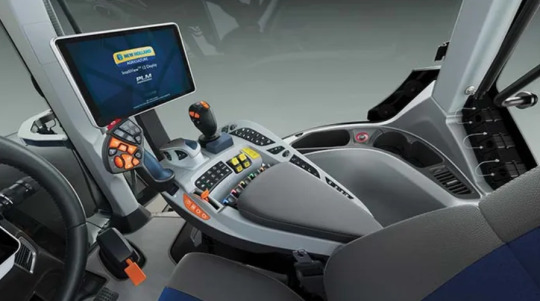
Yeah, not what any of us would have expected.
If you wanna be a mech pilot in 2025, go drive a tractor. I'm not kidding.
Once you're on the field, your hands aren't on the wheel, they're on this thing:
The big stick controls the course in the computer, the little one controls your tool, the many buttons toggle states (or what the little stick is currently triggering) and through these inputs you drive the tractor.
Steel Battalion is very fun, but it won't hold your attention for more than around 100 hours unless you're a real freak about tractors and just don't know it yet.
What's more, Steel Batallion isn't playable to anybody without the controller which limits how many people will be playing it and it isn't social or moddable like the successful games we talked about earlier.
Okay, so what can we do about this?
I think the one feature here that nobody talks about is that of input-agnosticism: The ability to bind your own inputs to something in the game (directly or indirectly through some middle thing) and get good results… But not in some hugely "okay bind 100 things using our controller, or use a keyboard and mouse" binary.
The binary is still not input-agnosticism, and it still will not work.
It has to be granular.
Input agnosticism results in controller agnosticism:
You can bind as much or as little as you want, and you can pass features you don't want to bind directly to a helper subsystem middle-man like an assistant or instructor which will perform limited tasks for you - while you provide the helpers context by telling them which of a limited set of goals you want to achieve.
Say, face a target, or a direction, or aim at a thing. It saves you mental time, though if you did it manually you might get better results (incentivising you towards experimenting in that direction).
Let's touch on why controller agnostic design is really what's needed here, and why its important:
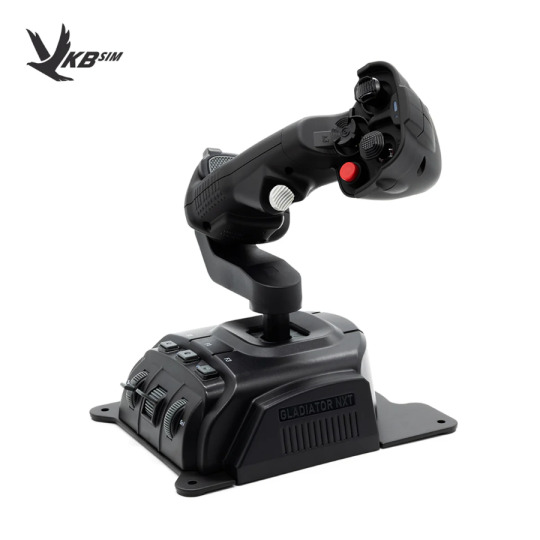
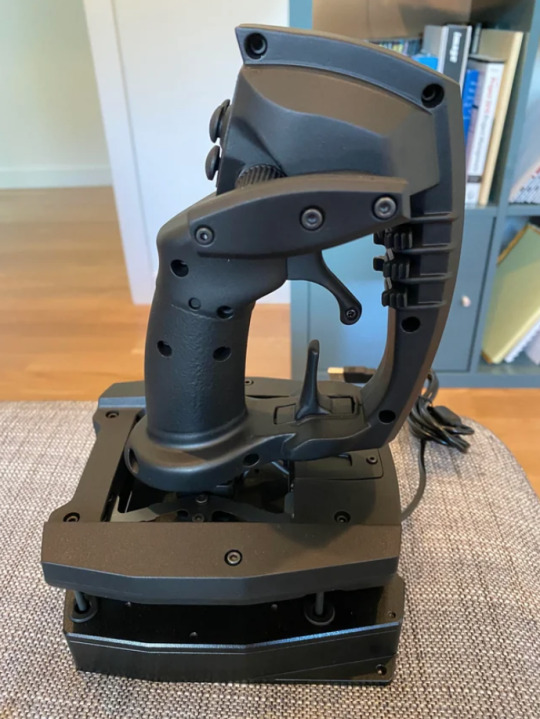
This is the omnithrottle, and and this is the Sublight Dynamics 6dof joystick.
The Omnithrottle tries to solve 6dof throttle management by adding an extra piece to a joystick at the bottom, turning the yaw z-axis-twist of the stick into a sort of vertical axis for direct up and down movement, ascending and descending.
The Sublight Dynamics 6dof joystick combines all six axis into a single device, and is an interesting experiment. I particularly like the puck switches ahead of the user's fingers, inspired likely by Evangelion which in turn was inspired by Sol Bianca's use of them.
We got great lessons in human factors for space dogfighting from both:
The omnithrottle produces huge fatigue if you use it in coupled mode (software assisted flight), because you have to hold the joystick base forward, fighting the springs. This is fine in decoupled mode (where you coast under newtonian force) but not everybody uses it. Likewise, if you remove that spring, you lose fine movement because you can no longer feel where the middle is anymore.
The SD6DOF creates a conflict in Fitt's law (speed and precision are enemies of each-other, and to get both you need a tool in the middle to help you) where some precision is lost due to the same muscles needing to drive more axis at once.
These are both many years old now, and over time we've seen many many solutions to this problem flop.
Well, VKB announced the Space Throttle Grip a few days ago, which rethinks the distribution of axis and combines the best features of both.
youtube
The key thing is, this is an evolutionary space with competing ideas. A healthy ecosystem.
And its only possible because the game's inputs are controller agnostic.
This doesn't just mean that it'll let you bind any input device directly to things, but that there are multiple ways to achieve your desired outcomes even on the software side with the helper middleman we talked about (in this case, coupling modes).
Does your machine turn to face an arbitrary vector which is the thing you actually steer or select (Warthunder)? Do you have direct input control? Do you haven an autopilot?
Here's a lecture by F22 Raptor test-pilot Randy Gordon talking about some of this stuff, giving you a frame of reference with a real vehicle which exists.
youtube
When you can pick between those goals them, you have what's called "a software" in human factors. Your two grips become arbitrary and are now called inceptors.
The software drives the machine, and you drive the software. You can override the software and provide a manual input, but the other elements you are not overriding will try to compensate to maintain a desired state. If you know how to manipulate this, it means you only need a small number of axis to achieve a very complex control action.
A great example is how long you hold the A-button in Mario changes how much power his jump has. The action is a versatile verb.
Imagine a person balancing. If their goal is to stay upright, and I push them, they translate across the ground and try to stay the right way up, turning that push force into horizontal force. They are following an instruction: remain upright.
If I make that person carry a very heavy thing, they compensate their body's balance accordingly. If I then use my finger and tell them to act as if I am pushing them with that gentle motion, they will respond but if they go too far they can say "hey, don't do that, I'll drop the heavy thing!" and ignore my pushing instruction -- because my directive telling them to remain upright superseded it.
We need to think of mecha in terms like these, and to do mecha, we need to make a standard of accessible rules like this which input devices can talk to via axis and buttons, with lots of middlemen.
Absolute (mouse-like) and relative (stick like) and accumiulated (driving a mouse with a stick by having a variable over time) and blended (driving a car with a d-pad with a simulated wheel that wants to return to zero all the time, replicating a stick) inputs must be middle-modes processing and digesting inputs in these ways. Curves matter. Biases and preferences must be accounted for.
This means finally solving "how" the giant robot works in software (even if its a design conceit), and then having systems which poke at the "how" to bias it in a direction toward an outcome.
My favourite version of this is a deliberately clumsy mech-game called Robot Alchemic Drive (RAD for short).
youtube
Playable on a regular PS2 controller, the triggers and bumpers drive the legs like a tank. The sticks drive the arms.
The robot's body has physics. You are controlling a thing.
There are no helpers to correct your motions other than when the robot stands up and to keep it upright (its otherwise 100% manual, playing back motion planning which gets fed into the physics) but yes, there is a simulated body here.
With helpers, this could get faster and way, way more fluent.
So how might these "helpers" in software work?
Think for example of how a body in motion continues to move. With a robot in a vacuum like space, you'd continue indefinitely. That's hard to control.
Do you automatically slow down and fake aerodynamic drag axially with your boosters to allow curved trajectories and soft stopping with a motion-control-decoupling-mode (as Star Citizen does), or do you have a breaking system a user can activate on a pedal or trigger, to apply those forces on different axis when they want them?
youtube
What are those axis bound to, the pelvis, the thorax, the head, the synthetic vision 3rd person camera?
These are really complicated questions, and this is just about how we make a vehicle come to a stop!
Now this might seem niche, but this exact same kind of thought also applies to how a robot balances, and how it digs its feet into the ground, creating torque or not situationally.
This isn't just fine grained motion like "moving our legs manually", but how and when we apply breaking force on the ground.
Do we apply it when we let go of the left stick?
Does the left stick prescribe a preferred velocity?
Does it prescribe input forces?
Do we change between these situationally, or maybe with a button?
Its important to think about these things.
"You're making this too complex!!"
"But why would we do this? What is the value? People are playing Armored Core 6 with a HOTAS!!"
Yeah, and that experience is not great, actually?
youtube
You're actually less capable than a keyboard and mouse-player, because Armored Core 6 isn't a game which simulates orientation over time (the body turns instantly as if by magic), so you're just driving relative inputs. You are literally disadvantaged.
Armored Core 6 has no "vehicle": This is an action-game's 3rd person control software. Its Elden Ring's horse, with a jetpack, and the roll replaced with a dash. Everything else is animations.
Its visually impressive, but there's something fundamentally missing:
Fahrvergnügen.
It means "driving pleasure" in German.
The feeling you get when you speed up going down hill, or you feel the give of the wheels against the road and the lean of the car when you take a corner.
When you bank against air in an aircraft, or turn faster than your velocity changes and you drift.
That good feeling, that's fahrvergnügen.
A game which really gets this I think is Armored Core: For Answer. I know many of you might have expected Mechwarrior here but the physics of Mechwarrior games are extremely simple, following an interpolative model.
youtube
Interpolative here means, a bit of calculus is used to ensure a smooth arching curve is how you go from zero to a high speed at all times, or a rotation, so on and so forth. This "smoothness" is the same smoothness present in Armored Core 6.
Armored Core For Answer on the other hand, is additive in how it calculates velocity per second, meaning your AC's velocity curve is inconsistent. The game has hidden stats calculating aerodynamic drag per part, it has a simplified model of angular momentum, and it has ground friction and its boosting system is different on each axis.
All of your inputs are analogue, including the angle of your boosters on left stick, and two booster-types: Your main booster handling like a motor-cycle throttle curve, and the other not only having many stages of output for flashes of thrust via contexts (combining motion and direction together to produce an intent) but also combos and even cancels. Its VERY sophisticated!
That's a lot of different factors to control. A lot of fahrvergnügen to be experienced when you master them, and feel ownership of them.
Lots of areas for skill expression.
This, combined with a rich weapon balance and a complex combat geometry (the emergent spatial and pressure rules of motion, aspects, angles and motions similar to the aircraft dogfighting) are why people are still playing this game today.
The match I uploaded was from four days ago, as of time of writing. People are still modding a game from 2008, limited to console by hacking the rom file's patches. Yeah.
I know among many game reviewers, "smooth" and "smoothness" is considered a compliment in game design (its easy to control), but interpolative motion really is the opposite of fahrvergnügen:
Interpolative suffers from feeling "zippy" and "hollow" when its fast, which is why lots of players and designers insist on slowing games down so they recover their fahrvergnügen.
You don't have to do things this way. A good mech sandbox should reward both fast and slow movement in its design!
There should be room for everybody to play!
In interpolative movement games, motion is already solved, to sell you the superficial power-fantasy (that you're good, despite not having learned how to be good) instead of giving you the experience.
Interpolation is insisting the burger you got at McDonalds is the same as the burger on the commercial. Like the burger at McDonalds, its also way way easier to make, and in today's market yeah, you take what's easy and known because you have economic pressures to get things done quickly.
You can't make a five star meal in a McDonalds kitchen, and the AAA games industry is the McDonalds kitchen of gaming.
So, what is a three star michelin meal, in terms of inputs, with additive movement?
You incentivise people with the cheaper stuff on the menu. That's robust helper tools which let keyboard and mouse players, or gamepads interact fluently.
Its affordable, and easy and gets people invested in your experience.
Then when people use fancy controllers, you get better response-rate. Because everybody buys into the mecha fantasy when they play, being beaten by someone who is controlling more complex control factors more directly at once (making them a better pilot) feels fairer.
They are negotiating the machine's limits better than you are.
You both know they more "an char" than you are:
youtube
It becomes aspirational, rather than annoying, which is how the culture of space-simming, and flight-sims, and other vehicle sims express this. It also fits the mecha fantasy, because those with basic controls are your grunt units.
We see this if we look at cockpit controls in Gundam: A Jegan's control inceptor is way simpler than say, Unicorn's.
It is just part of the fantasy.
So let's talk about these limits we negotiate.
It means, some kind of vehicle must be simulated in software, even if its a very simple abstraction purely enough so it feels good for players.
Also, I say "a software" or "helpers" what do I mean?
I don't just mean the simulated vehicle, but a robust modular middle system in the "player controller" part of the game simulation which interprets desired outcomes from a pilot user or operator and tries to achieve them.
Here's an example, let's talk about Armored Core's lockon system, which uses a software stack to turn your intention into an outcome in exactly this way.
Your robot's simulated sensors (radar, visual, etc) detects a list of potential targets…
Which uses camera orientation of a synthetic vision system to give you comprehensive 3d awareness to determine which target is interesting to you…
After selecting the target, it passes that information to the fire control system which computes a trajectory from its position and velocity…
This then talks to your weapons which know how fast your bullets go…
and this picks where to lead along that trajectory…
then that location is sent to the arms to execute that command…
Which then sends the state of this command chain to your HUD, so you understand what the body of your robot is currently trying to achieve.
Each step is influenced by ingame statistics and simulated mechanical limits -- meaning, how well you can lock up, or even select a target is very important.
You can't instantly put a cursor on something and bot a game, because everybody already has a deliberately limited aimbot, it came with your robot, to negotiate its deliberately limited body.
The key thing is, this is much much faster and more effective than you could as a human select the target manually and hit accurate than you could with round velocities -- with most videogames hiding this with hitscan (instantaneous bullet) weapons meaning whatever you click on is hit right away.
When the round takes time to get there, things are far more difficult. This is why almost nobody uses manual aiming unless they're throwing explosives at big bulky targets in AC.
From limitations like this, booster performance, turn-rate, and so on and so forth -- the negotiation of limits produces a combat geometry and how well you understand that combat geometry, and how well you understand your abilities to your opponents abilities dictates how the fight will go.
We see something somewhat similar in Steel Batallion with the lockon system but we also have a lot of deep manual control over our VT's orientations which change its balance and so on. Steel Batallion is in fact, one of the few games where your robot can fall over and get back up.
This is exactly how DCS and Star Citizen also work, and very similar principles apply in Eurotruck Simulator and Farming Simulator via the fuel, cooling, air, combustion cycle, and transmission, and shock absorbsion systems of your vehicle.
Okay, so now what?
I've been thinking for a while now about writing what I think would be the mech-game equivalent of the paper Tim Berners Lee wrote for the web (Information Management: A proposal) going into what I think the simulation would really need, what the software would need, what the controller would need and some suggested practical strategies for solving these problems based in real research I and others have done.
The system I've already built solves for fire control, fine arm motion, head movement, independent pelvis and foot motion, the operation of boosters and other similar systems in a 6dof environment which accounts for gravity, aerodynamics, balancing, alignment and full motion control -- all on a standard game controller. Its not modular yet, simply because I am not a skilled programmer, and would need real help to do this.
There's also game-design research here, which would ensure the combat geometry would reward skill expression via investing in that agnostic game design, so the control skill aligns with the power-fantasy through skill expression. This means no one strategy becomes overwhelming.
It likewise, also has the "for gamepad and keyboard/mouse" solve which would be needed to ensure its accessible for those who aren't ready yet for custom controllers.
In turn, it also has considerations and proposals for such likely controller designs and probable strategies of employment which of course translate and map to two big sticks, in a HOSAS (Hands on Stick and Stick) layout.
So what's your ideal controller?
Less a controller, and more a principle:
Key to the proposal is you can scale up the amount of control bindings, or scale it down passing automation to helper subsystems which take your intention and act on it in a useful way.
You could have just two plain sticks with foot pedals, or you could go ham and have some complex force feedback device with tons of inputs -- because of this input agnosticism.
The secret sauce I think to the highest end control is the use of software defined force-feedback not only for the two big sticks, but also four smaller ones: one each for your thumb, and one each for your finger on each hand, and an analogue trigger. I've seen this solved in open source projects, so its entirely doable.
What does this actually mean?

Source: KAIST-HCIL/FS-Pad
The purpose of a force-feedback stick is software defined -- driving the camera, pelvis, upper body, boosters, walking etc variably, with the feedback not necessarily telling you about the environment -- but also by providing what amounts to new input devices.
To explain, force feedback works by providing input to the stick like a robot arm and is not at all like a rumble feedback device. This means the position the stick "wants to return to" at any given time is not defined by springs like it is in a conventional controller, but by active software which can update in real-time.
This means resistance can be different in different directions, or the stick can even hold a position you give it in one axis but not another, replicating a hat switch or a flight throttle.
I've looked at many different open source projects which achieve these outcomes both on thumb-sticks and main sticks with great outcomes, and I think a prototype could be made if I had a team, or other people to work with.
If interest is expressed, I'll produce a specification proposal for what this input agnostic design in software needs to be (eg, how the robot is controlling) in strictly defined terms which can be implemented.
You can already see it on my Tumblr account as TOMINO, NAGANO, etc where I go into some of this -- all of which works on a standard controller, but adapts extremely well to a large HOSAS.
Likewise, I'd (eventually) also produce a proposal for a controller design which meets this specification.
I've been testing this concept on and off for many years now in Unreal Engine (I'm not a skilled programmer, not skilled with CAD or electronics, depression limits my effective outcome returns -- but I'm still getting very promising outcomes).
Ultimately what I'd really want access to is expertise and help, since my background is mainly thinking about and designing solutions for problems not necessarily implementing them -- and I'm essentially on disability, so I have unlimited time to think about this.
I don't want to ask for money, which I figure is the thing everybody is anticipating: I'd rather get this done than make money from it.
In conclusion?
To solve this what's needed isn't some figure of brilliance in a basement or garage somewhere, but an organic ecosystem of designers and builders responding to pressures, and we've already see that work many times very well.
In our case, nobody has defined the vehicle or the modular helpers in a way robust enough to capture every fantasy effectively.
That's the issue.
tl;dr coming away from this:
For the controller to exist, you first must have something to control.
To be a pilot, you first need a vehicle.
--
Live forever, Apes.
#.AskOsaka#Mecha#Mech#Mech Design#Game Design#Peripheral Design#Peripheral Concepting#human factors engineering#Human Factors#Scifi
105 notes
·
View notes
Text
Why Kenya's Agritech Startups Struggle to Penetrate the Market Despite Strong Investment
Discover why Kenya’s agritech startups struggle with market penetration despite strong investment, and explore how regulatory challenges and fragmented services hinder growth in the sector. Kenya’s agritech industry faces hurdles beyond funding, including complex regulations and data security concerns. Learn how startups can overcome these challenges to scale and succeed. Uncover the key barriers…
#agricultural technology Kenya#agritech ecosystem#agritech innovation challenges#agritech investment Kenya#agritech market penetration#agritech partnerships#Agritech Startups#AI in farming#climate resilience farming#data privacy in agriculture#data security agritech.#digital agricultural transformation#digital farming tools#digital financial services for farmers#farmer adoption of technology#fragmented service providers#IoT in agritech#Kenya agritech challenges#Kenya’s digital ecosystem#Mercy Corps AgriFin#public sector data in agriculture#regulatory barriers agritech#small-scale farming Kenya#smart farming Kenya#stakeholder engagement in agritech#sustainable agriculture Kenya#tech solutions for farmers#technology adoption barriers#technology-driven agriculture
1 note
·
View note
Text
CLİPART - DRAGON+ (5)

The historical development of farm clipart has evolved significantly over time, reflecting changes in artistic styles, technological advancements, and cultural influences. Initially, farm clipart consisted of simplistic and rudimentary drawings of basic farm elements such as barns, animals, and crops. As graphic design tools and techniques advanced, farm clipart became more detailed and realistic, capturing the essence of farm life with greater precision and creativity. With the rise of digital platforms and online marketplaces, farm clipart has become more accessible and diverse, offering a wide range of options for designers and creators to incorporate farm-related visuals into their projects. The evolution of farm clipart mirrors the evolution of farming practices and the agricultural industry, showcasing the deep connection between art, technology, and cultural representation in visual storytelling.
Similarly, the evolution of history clipart has followed a trajectory of innovation and adaptation to changing artistic styles and educational trends. Historically, history clipart primarily featured iconic historical figures, landmarks, and events depicted in a simplistic and educational manner. As digital platforms and educational resources developed, history clipart expanded to include a broader range of topics, styles, and visual interpretations. Modern history clipart encompasses a diverse array of historical themes, from ancient civilizations to contemporary global events, catering to the varied needs of educators, students, and enthusiasts. The evolution of history clipart reflects society's evolving interest in history, visual literacy, and the power of imagery to convey complex historical narratives in a compelling and informative way.
The trends in food clipart styles have undergone a transformation in response to changing culinary preferences, design aesthetics, and cultural influences. Initially, food clipart featured traditional depictions of common food items such as fruits, vegetables, and dishes in a realistic and straightforward manner. However, as culinary diversity and visual storytelling evolved, food clipart began to incorporate more stylized, artistic, and thematic elements to convey the richness and diversity of global cuisines. From minimalist food illustrations to vibrant and whimsical food compositions, the trends in food clipart styles reflect the fusion of creativity, technology, and culinary appreciation in visual design. By exploring different food clipart styles, designers and content creators can enhance their projects with visually appealing and culturally resonant food imagery that engages and inspires audiences.
343 notes
·
View notes
Text

The Princesses of Oz
Well, for the first week of June, I'm going to be on a long vacation to Orlando, Florida, and visit nearly all the major theme parks located there. As such, I would not have time to make Dorzma artworks as frequently as I want to… and I know of the legal battles between Disney and DeSantis over the "Don't Say Gay" bill or whatever nonsense is going on.
So instead, I make Dorzma artworks in advance. And for this one, I wanted it to be like a book cover, a poster for people to put on their walls. You might say a royal portrait. And indeed, that's what I was going for.
Instead of using the traditional anime-style ink pen and cel-shaded filling, I decided to go for a more painted feeling. This meant the outlines were done with dark sketch pencils, and the colors were painted with digital acrylics, both wet and dry, and maybe a few watercolor brushstrokes here and there. It's meant to give the impression that an artist was commissioned to paint a royal portrait of the princesses to later display in one of their hallways (or maybe in a museum).
For this reason, I had to design a new outfit for Dorothy to be more fitting of a princess rather than a farm girl. Since Ozma was considered to be a princess (despite technically being queen), it made sense that Dorothy would have a white dress similar to Ozma. Given that Dorothy was not the descendant of King Pastoria and Fairy Queen Lurline, I felt she could inherit the original design of Ozma's dress with the Oz emblem at the center of the neck collar.
Obviously, since this would take place after Dorothy's family permanently moved to Oz, Dorothy can now wear the Magic Belt of the Nome King freely. And being a princess, Dorothy out to have a crown of her own. I decided to go with the book design with a nostalgic look back at my very first Oz artwork. Dorothy would have a crown made of silver that glitters so brightly.
It may not be emerald, but it makes Dorothy feel like a young apprentice of Glinda the Good, and I want the audience to feel like Dorothy is training to be a good witch herself.
The Oz banner, was there to give a finished polish for the portrait. Made it through symmetry tools and careful observation. For the background, it was a pain to figure out what goes on there. I planned windows, thrones, and gardens to go there. But I settled with a foggy, brief glimpse of the Emerald City with Dorothy and Ozma standing by one of the gardens.
#procreate#my art#my art stuff#dorothy gale#princess ozma#ozma#land of oz#ozma of oz#princess dorothy#oz#wizard of oz#oz books#dorzma#dorothy x ozma#lgbt couple#lgbt art#digital art#pride month#magic belt#sapphic#wlw#dorzma month
44 notes
·
View notes
Text
Today, the US Federal Trade Commission filed a lawsuit against farming equipment manufacturer Deere & Company—makers of the iconic green John Deere tractors, harvesters, and mowers—citing its longtime reluctance to keep its customers from fixing their own machines.
“Farmers rely on their agricultural equipment to earn a living and feed their families,” FTC chair Lina Khan wrote in a statement alongside the full complaint. “Unfair repair restrictions can mean farmers face unnecessary delays during tight planting and harvest windows.”
The FTC’s main complaint here centers around a software problem. Deere places limitations on its operational software, meaning certain features and calibrations on its tractors can only be unlocked by mechanics who have the right digital key. Deere only licenses those keys to its authorized dealers, meaning farmers often can’t take their tractors to more convenient third-party mechanics or just fix a problem themselves. The suit would require John Deere to stop the practice of limiting what repair features its customers can use and make them available to those outside official dealerships.
Kyle Wiens is the CEO of the repair advocacy retailer iFixit and an occasional WIRED contributor who first wrote about John Deere’s repair-averse tactics in 2015. In an interview today, he noted how frustrated farmers get when they try to fix something that has gone wrong, only to run into Deere's policy.
“When you have a thing that doesn’t work, if you’re 10 minutes from the store, it’s not a big deal,” Wiens says. “If the store is three hours away, which it is for farmers in most of the country, it’s a huge problem.”
The other difficulty is that US copyright protections prevent anyone but John Deere from making software that counteracts the restrictions the company has put on its platform. Section 1201 of the Digital Millennium Copyright Act of 1998 makes it so people can’t legally counteract technological measures that fall under its protections. John Deere’s equipment falls under that copyright policy.
“Not only are they being anti-competitive, it's literally illegal to compete with them,” Wiens says.
Deere in the Headlights
Wiens says that even though there has been a decade of pushback against John Deere from farmers and repairability advocates, the customers using the company’s machines have not seen much benefit from all that discourse.
“Things really have not gotten better for farmers,” Wiens says. “Even with all of the noise around a right to repair over the years, nothing has materially changed for farmers on the ground yet.”
This suit against Deere, he thinks, will be different.
“This has to be the thing that does it,” Wiens says. “The FTC is not going to settle until John Deere makes the software available. This is a step in the right direction.”
Deere’s reluctance to make its products more accessible has angered many of its customers, and even garnered generally bipartisan congressional support for reparability in the agricultural space. The FTC alleges John Deere also violated legislation passed by the Colorado state government in 2023 that requires farm equipment sold in the state to make operational software accessible to users.
“Deere’s unlawful business practices have inflated farmers’ repair costs and degraded farmers’ ability to obtain timely repairs,” the suit reads.
Deere & Company did not respond to a request for comment for this story. Instead, the company forwarded its statement about the FTC's lawsuit. The statement reads, in part: “Deere remains fully committed to ensuring that customers have the highest quality equipment, reliable customer service and that they, along with independent repair technicians, have access to tools and resources that can help diagnose, maintain and repair our customers’ machines. Deere’s commitment to these ideals will not waiver even as it fights against the FTC’s meritless claims.”
Elsewhere in the statement, Deere accused the FTC of "brazen partisanship" filed on the "eve of a change in administration" from chair Lina Khan to FTC Commissioner Andrew Ferguson. The company also pointed to an announcement, made yesterday, about an expansion to its repairability program that lets independent technicians reprogram the electronic controllers on Deere equipment.
Nathan Proctor, senior director for the Campaign for the Right to Repair at the advocacy group US PIRG, wrote a statement lauding the FTC’s decision. He thinks this case, no matter how it turns out, will be a positive step for the right to repair movement more broadly.
“I think this discovery process will paint a picture that will make it very clear that their equipment is programmed to monopolize certain repair functions,” Proctor tells WIRED. “And I expect that Deere will either fix the problem or pay the price. I don’t know how long that is going to take. But this is such an important milestone, because once the genie’s out of the bottle, there’s no getting it back in.”
41 notes
·
View notes
Text
party in the minecraft server hcs ^^
the sever itself
owned* by bonnie (actually maintained by odile but she gave bonnie the owner tag because they wanted it so bad)
everyone has it under a different name on their own devices but officially the server is called the digital familytale
modded semi vanilla* (for the most part. theres a morbillion science mods added for odiles sake specifically, a few furniture mods for mira and a clothing mod for isa though)
mainly on peaceful but will sometimes be bumped up to easy for resources or fun
mira
tends to a village nearby the family's house that she has expanded tenfold from its original starting point
cares deeply for all of the villagers and has used a name tag on each and every one of them. they all have their own personalities and stories
brews potions on demand, so long as you bring her the ingredients
likes to play on easy mode when on the server by her lonesome in order to collect resources
will not step foot into the nether. not even for the pretty light wood (even if she really really wants the pretty light wood)
tool order: wand -> rapier -> crafted crook. the wand is essentially a long ranged weapon that can both attack and heal, but is mostly used for the latter. the rapier was specifically modded in for her. the crook is a multipurpose tool, combining shovel, axe and pick into one tool
isa
built a big barn
loves his big barn
is constantly talking about, working on, and admiring his big barn
is the guy to come to if you need any sort of animal produce or need to borrow a horse. owns at least three of any type of animal at all times
will get on with mira to help defeat mobs to make things go by faster
in charge of armor, tools and upgrades. spends a lot less time on any of that and a lot more time on making fun clothes, though
built a little storefront to pretend to sell his clothes from in mira's village. does often actually change the villager's outfits for funsies
tool order: gauntlets -> axe -> pick -> shovel. when wearing the gauntlets they will cover both hands of his model and do damage comparable to an iron sword twice (once with each hand) before a short cooldown
odile
couldnt really get into it before adding mods. now has the most playtime. even if you totaled everyone elses playtimes, odile would just barely eek out over it (if you took out siffrins, who's the closest to rivaling her, it wouldnt even be a competition)
the minecraft wikierrrrrrrrr. keeps that shit on tap even though she has memorized many of the recipes
always striving to make a project bigger than the last
redstone queen
regularly visits the nether to trade with piglins. one of the mods has them rebuild their structures if they notice the gold has gone missing. she pilfers it again every visit without fail
tool order: sword -> pick -> shovel. doesnt harvest wood so deems it unnecessary to carry an axe
bonnie
has an obscenely large, unautomated farm. they will spend entire days afking near the farm just so it grows. more often than not when theyre afk during one of these sessions, theyre off making real snacks for everyone
didnt understand and therefore didnt care about redstone until odile taught them. the day after, everyone logged on to the Laggiest Server Ever. when they went to investigate, bonnie showed off their extremely over complicated redstone contraption that did nothing more than activate a charge. nobody had the heart to tell them it was the cause of the lag spikes, so they suffered through it for like a week after until bonnie came to the realization themself and tore it down
completely and utterly dedicated to making a redstone rollercoaster of some sort. at some point. definitely. its 100% on the to do list, bet
teleports to everyone randomly to deliver meals. some good indicators youre about to get a visit from the Snacks God is 1) you mentioned the fact you have no food on you, 2) theyre talking about one of their recent harvests, and 3) "hey are u somewhere scary rn"
unable to die due to isa making them an accessory called the eternal necklace of undying. so long as you have it on in the charm slot, youre completely unkillable. bonnie was Extremely happy about this, as it meant they could finally leave creative and would stop accidentally breaking things left and right. it took many weeks of work to craft, and as thanks, bonnie made him his favorite meal in real life three days in a row
tool order: hoe -> shovel -> axe. does not carry weapons
loop
keeps offering to make a mob spawner for ease of access to mob resources and exp. nobody want them to because spawners are big and ugly but loop is adamant about the fact they can make it pretty (they end up making one very far away from the house once. they were not able to make it pretty.)
loves the bow and arrow but hates the crossbow. does not carry any weaponry outside of that
has an area they call Loop's Paradise! the only thing located there is a lone interactable beach chair near the beginning of a large ocean, a single redstone lamp that powers on when the sun sets and a jukebox. when asked what makes this a paradise they simply say its peaceful (they are blasting Cure for ADHD - 30 min of Breakcore from the jukebox)
tool order: bow -> pick -> axe. chooses to break dirt and the like with their hand or some other thing on their person
siffrin
has given everyone a flower that he thinks resembles them and a pot to put it in
survives mainly on fish, but makes sure to focus on the meals bonnie gives him first and foremost
doesnt like playing off of peaceful if he has the choice
has tamed an obscene amount of wolves. leaves the majority of them in isa's care and exactly one in loop's. they all have names. loop's dog is named starbit
tool order: dagger -> pick -> shovel -> axe. the dagger was specifically modded in for them
↓
#in stars and time#isat bonnie#isat odile#isat mirabelle#isat isabeau#isat siffrin#isat loop#hcs#lols#im so serious this post got out of hand i spent an hour making it. I only wanted to make it so i could post the funny video#But then the autism hit. You understand.#laikas nebulous narrations
146 notes
·
View notes
Text
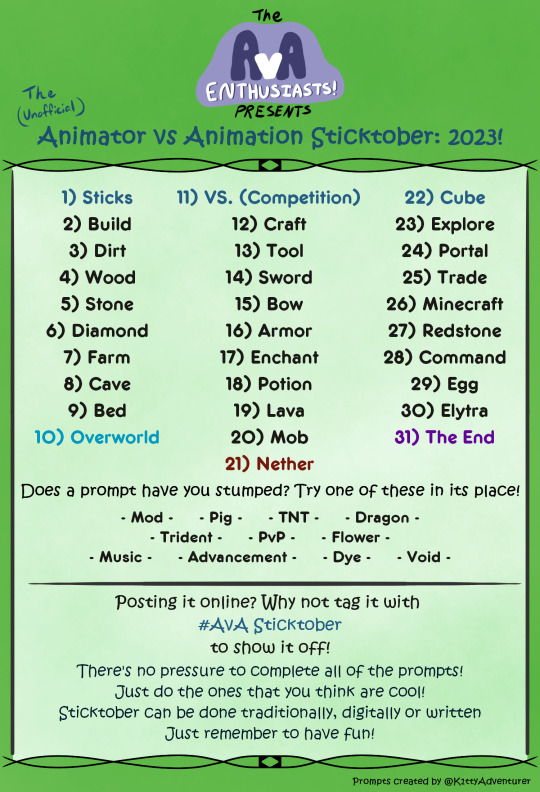
Hello Hello AvA Fandom!
Welcome to Animator vs Animation Sticktober 2023!
As per usual, this prompt list was created by @k1ttyadventurer with me as the organizer!
For those new to this, AvA Sticktober is a yearly art challenge inspired by the Inktober art challenge where you draw something in ink everyday based on a prompt list!
AvA Sticktober works similarly, expect you can do any of these prompts in any way you want! Traditionally, digitally, written, or arts and crafts? Heck yeah! Want to combine 2 prompts into one? Go for it! Don’t know what to draw for one prompt? Replace it with one of substitute prompts provided!
There’s no pressure to complete all of them if you don’t have the time or just don’t want to! The art challenge is all about having fun!
AvA Sticktober starts on Oct. 1 and ends Oct. 31!
If you fill out any prompts, post it with the tag #AvA Sticktober to share it with others! I’d love to see what you all create!
Typed out Prompt List below:
Sticks
Build
Dirt
Wood
Stone
Diamond
Farm
Cave
Bed
Overworld
VS. (competition)
Craft
Tool
Sword
Bow
Armor
Enchant
Potion
Lava
Mob
Nether
Cube
Explore
Portal
Trade
Minecraft
Redstone
Command
Egg
Elytra
The End
Does a prompt have you stumped? Try one of these in its place!
Mod
Pig
TNT
Dragon
Trident
PvP
Flower
Music
Advancement
Dye
Void
#Alan Becker#AvA Sticktober#AvA Sticktober 2023#animator vs animation#animation vs minecraft#avm shorts#ava shorts#ava#avm#art challenge#Sammy8D says#stick figures#ava enthusiasts#Sammy8D Stick Stuff
332 notes
·
View notes
Note
seems like for the qilik, obligate sophontry interrupted the transitional proto-avian glider stage and the hands are of some rationale trouble for an otherwise beak-using lineage. have you considered having the digit based tool use stem from increasingly dexterous handclaws to pry insects out of bark and tree trunks? i mean clinging to the side of trees is the general vibe of proto-avian gliders, and clades that focused on beak use for catching prey on the wing would continue into true avian lineages, while solidly gliding lineages focusing on digging for buggies woulda coulda shoulda be pushed by desertification/forest collapse occuring at geological speeds greater than that of evolutionary adaptation into terrestrial obligate sophontry. maybe. maybe they farmed termites or something. love the world hope they get that cow to the place :)
That's a really good idea, i think I'll go with it...
It fits perfectly with established lore of them having stemmed from climbing/gliding proto-birds (I haven't picked out a definite place in clade avelae (esp since the 'trees down' hypothesis of avian flight is contested) and there's some tremendous artistic license taken there, I've referenced microraptors and auorinis most for anatomy).
Also fits very well with established lore that they are predominantly insectivorous with populations outside of forested regions relying more heavily on vertebrate prey, and the fact that they have a pre-historic coevolutionary relationship with a species of ant, AND with the fact that their terrestrial lifestyle developed in response to fragmentation of forest habitats (separate to the 'contemporary' climate change event in the setting, which resulted in behaviorally modern qilik fragmenting into three distinct subspecies)
I'm thinking it would probably be the 'thumb' digit that is most specialized into tearing bark (as a better excuse for opposability lol) while the other two digits remain strong and flexible with curved claws to grip bark and assist with tearing. A flexible 'thumb' used to extract insects from bark could give way to more specialized tool use than could be accomplished with the mouth (probably stripped twigs to 'fish' for ants/termites in a similar fashion to chimps).
Their tool use probably predated this adaptation, ancestral gliding qilik may have been corvid-like in intelligence, but more dexterous manipulating limbs would allow for refinement in tool use and reinforce the ''hand''s dominance as a manipulating limb over the beak. And this would be further reinforced by a more terrestrial lifestyle.
As it stands their wing and hand anatomy is like this with great diversity in extent of feathering, given their flight feathers are vestigial in all three subspecies, which themselves are highly hybridized (flight feathers are most retained in only the most genetically isolated populations that dwell in forests and cliffs, where they are used for wing assisted incline running and to slow falls (though no anatomically modern qilik are capable of actual gliding)).
Sloppy as hell ref image
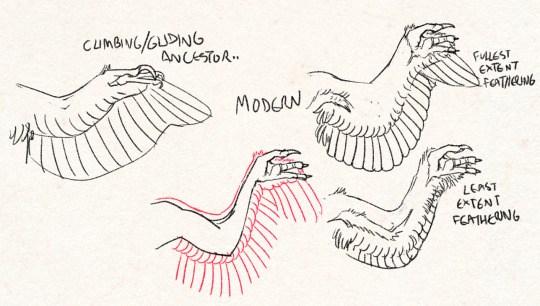
They have lost their curved gripping claws on their 'fingers' but retain a shorter version of the probing claw on their 'thumb'. I definitely need to refine the anatomy here but it's a start
70 notes
·
View notes